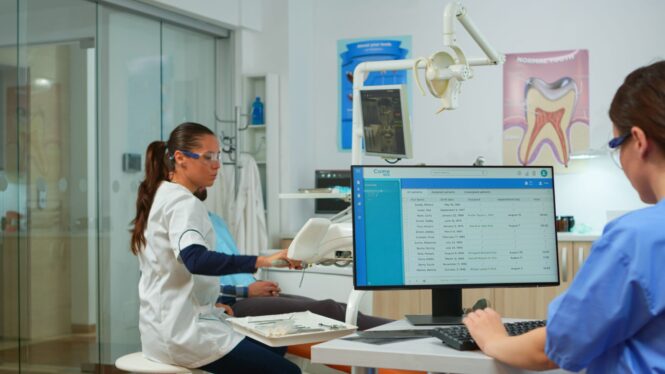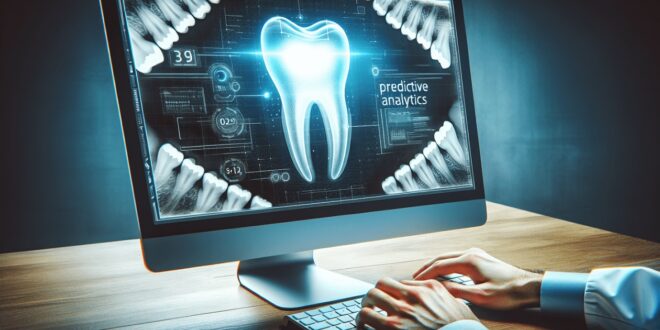You step into the clinic just as your first patient settles into the chair. The team huddle is done, the day’s schedule humming on the screen. You’ve already scanned last-night’s lab results and reviewed yesterday’s no-show table — and yet, there’s still that uneasy question:
Which patients today might need something extra?
What if you could slide effortlessly from reactive care into something pre-emptive?
That’s where the growing role of predictive analytics in oral care comes in.
This article explores how forward-looking data tools are helping dental teams anticipate issues, allocate resources smartly, and deepen patient trust.
We’ll walk through what predictive analytics really means in dentistry, how it’s shifting workflows, what practical steps you can take, and what the human side of this change feels like.
What we mean by predictive analytics in dentistry

At your fingertips are years of patient charts, radiographs, treatment plans and hygiene records. Traditional analytics might tell you what happened yesterday – production, hygiene re-appointment rates, cancellations.
Predictive analytics, on the other hand, uses those historic and current data sets to estimate what might happen next.
Think of it as your behind-the-scenes assistant spotting patterns: which patients are most likely to cancel, whose enamel erosion might accelerate, which treatment plan might be declined.
According to the definition, predictive analytics encompasses data mining, modelling and machine-learning techniques that draw connections among variables in large data sets to forecast unknown outcomes.
In dental-care settings, that means combining past clinical findings, patient behaviour, lifestyle indicators and sometimes genetics to assess risk and guide actions.
When you adopt tools like Trust AI, you’re signalling a move from “we’ll see how it goes” to “we can make a proactive plan”. Using such platforms, the idea of trust AI isn’t about handing over control, it’s about gaining insight that empowers your team.
Why this shift matters for the practice and the patient
When you’re managing multiple patients and a growing caseload, even small workflow tweaks can mean less stress — and more attention for the person in the chair. Predictive analytics offers gains on both sides.
For the practice
- Fewer last-minute cancellations. Algorithms identify patients with a high no-show risk so you can send targeted reminders, reschedule proactively.
- Better inventory and staffing planning. You can anticipate busy vs. slow days, align your hygienist or front-desk resources accordingly, reduce wasted supplies.
- Financial forecasting becomes cleaner: you see what revenue may look like, which treatment plans might stall, and where to intervene early.
For the patient
- Care moves from standard check-in to personalised prevention: instead of “come every six months”, you might say “based on your records and habits, let’s plan for a fluoride session now and revisit in four months”.
- The trust factor improves: patients feel you’re not just reacting, but genuinely watching out for them. One clinician noted up to 30 % faster turnaround on care acceptance when patients saw this level of tailored insight.
- Emotional load is lower: fewer surprises (for patient and team), fewer emergency visits, a smoother experience.
Did you know? One 2020 review found that big data approaches in dentistry (including predictive analytics) were most effective when they pulled data not just from the patient chart but from lifestyle, behaviour and socio-economic factors as well.
How it works in practice – tangible use-cases
Let’s pull the abstract into something concrete. These are scenarios you might recognise.
Use-case table
| Scenario | Data inputs | Outcome | Benefit for team/patient |
| Cavity risk assessment | Past cavity history + diet questionnaire + saliva/fluoride levels | Predict risk level, schedule preventive sealant | Less invasive care, stronger patient trust |
| Appointment no-show prediction | History of no-shows + time of day + reminder history | Identify likely no-show, send extra reminder or overbook | Fewer gaps in schedule, improved revenue stability |
| Treatment-plan acceptance | Demographics + previous case acceptance + communication history | Flag patients likely to hesitate, prepare targeted discussion | Higher adoption rates, smoother workflow |
| Inventory planning | Usage history + procedure schedule + seasonality | Forecast supply needs for coming week/month | Lower waste, better cost control |
Each of these might reduce friction in your day: less triage, fewer surprises, more time for the person in the chair.
A note of caution: Data tools don’t replace your clinical judgement. They sort what’s most likely; you still decide what’s right for each patient.
Challenges and practical considerations for the dental team

It is warmly hopeful to embrace predictive analytics, yet it’s equally important to approach with realistic eyes. From my time in clinics, I’ve seen excitement slow when the “human side” wasn’t addressed. Here are key checks:
- Data quality matters. Garbage in, garbage out. If your patient records are inconsistent or fragmented, predictive models lose value.
- Workflow integration. A slick dashboard is not helpful if it sits outside your routine. Choose tools that work within your existing systems (PMS, radiograph viewer, hygiene software).
- Team buy-in and training. The front desk needs to believe the extra reminder is worth the prompt. The hygienist must see relevance in new risk scores. The dentist must trust the model enough to act.
- Ethics and transparency. When you tell a patient “based on your risk profile we’re doing X now,” you’ll want to explain why. These tools should augment, not obscure the patient-clinician conversation.
- Patient privacy and security. With more data integrated (diet, habits, health background), compliance and consent become even more central.
- Cost vs benefit. Especially in smaller practices, budget matters. Some platforms charge per-seat or per-data point. Weigh the expected time saved or improved outcomes against that cost.
“One clinician told me the moment their software auto-populated post-treatment notes felt like a gift.” That’s the kind of shift we’re chasing here.
How to begin – a practical-first roadmap

Thinking of moving into predictive analytics? Here’s a phased approach tailored for a dental practice.
- Audit your data and workflows. What data do you already capture (e.g., recall frequency, hygiene scans, cancellations)? How clean is it?
- Choose a focused pilot. Don’t try to “predict everything” at once. Start with one manageable use-case (say, reducing no-shows).
- Select a partner or platform. Look for systems that integrate with your PMS, offer clear dashboards, and allow you to export or act on identified risks. Consider platforms that emphasise the user experience.
- Train the team and define roles. Who monitors the risk alerts? Who sends the patient outreach? How will you document the action taken?
- Measure outcomes. Before and after: number of no-shows, case acceptance rates, time saved per staff member.
- Iterate and scale. Once one use-case is working, expand to others (e.g., predictive preventive care, inventory forecasting).
- Communicate with patients. Include risk profiling as a value-added component of your care. Patients appreciate when you say: “Because we can now see you have slightly elevated risk for enamel breakdown, we’re planning a short-visit preventive strategy.”
When you do this methodically, you’re not just implementing tech, you’re improving decision-making, freeing up mental bandwidth, and enhancing patient experience.
Final thoughts
In a packed morning schedule, any tool that buys you time, clarity and stronger connection with your patient is worth attention.
The growing role of predictive analytics in oral care offers precisely that: a smarter way into prevention, a smoother workflow, and more meaningful conversations. It doesn’t replace your experience, it augments it.
As you walk into your next appointment, imagine the quiet assistant sitting beside you, flagging subtle risk, nudging the team ahead of time, and helping you shift from What now? to What next? That shift might be the difference between simply managing appointments and truly anticipating needs.
 Imagup General Magazine 2025
Imagup General Magazine 2025
